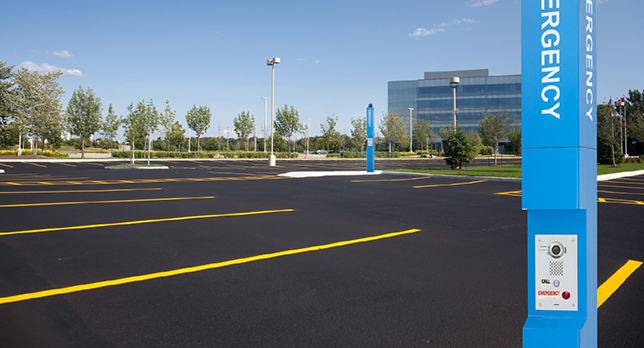
Enhancing Parking Lot Emergency Communication with Intercoms and Emergency Towers
By Brad Kamcheff
Parking lots and parking garages come with their own unique set of security challenges. Because parking structures are often quite large, void of many people, and usually located far away from a physical building, it’s more challenging to ensure the safety of users. In a large parking garage, the ability to find help in the event of an emergency can prove very difficult.
While surveillance systems can monitor a parking lot and are often used to identify people with bad intentions, to confirm parking lot slip-and-falls, and other events, these systems do not provide a way for people in a parking lot to actively reach out for help. Ensuring proper security is in place is especially important in campus environments, where there is a high concentration of vehicles and people, combined with numerous surface parking lots and parking structures that need to be actively monitored.
The presence of intercoms, along with emergency towers, provide a critical layer of security and emergency communications for people in need of assistance.
Communication on Every Level
Parking garages are often multi-level, maze-like structures. While it can be difficult to travel through parking garages in a vehicle, they can be even more challenging when a person is on foot.
Intercom systems placed throughout a parking garage provide visitors with a readily available communication tool for help. Whether they’re trying to locate their vehicle, need assistance because they are locked out of their vehicle, or need assistance when paying for parking, intercoms can be placed in a combination of locations, from the entrance gate where a person takes a parking ticket, to near a bank of elevators or stairwells.
In addition, emergency towers can be used throughout parking garages to help with more pressing communications, providing an easy-to-locate communication tool. When a video intercom system is located inside a parking garage, it allows a security officer to clearly hear and speak with the individual who is calling about an emergency. An optional overhead camera attachment can also provide a bird’s-eye view of the person in distress.
Reliable, Networked Connectivity
In the event of an emergency, many people instinctively turn to their mobile phones to call for help. But with any outdoor space, or in an underground parking structure, it can be hard to determine whether a specific area will have reliable access to a cellular network.
Intercom systems and emergency communication towers rely upon a hardwired connection to ensure consistent communication. This eliminates the chance of a dropped call that is dependent upon a cellular network.
In addition, it can sometimes be difficult for someone requesting help to clearly describe where they are located—especially if the person is in a large campus parking lot or an unfamiliar area. When someone presses a button on an emergency tower, the person on the receiving end knows exactly where that tower is located, taking the guesswork out of trying to pinpoint a location in a sea of vehicles.
Easy to Locate
When someone is faced with an emergency outside of a building, it can be difficult to locate other people who can provide assistance. Now put that emergency into a parking lot, and that challenge becomes even greater.
Large parking lots are not always filled with a constant stream of people. During certain times of the day, they can even be void of other vehicles.
With their tall shape, bright coloring, and glowing beacon at the top, emergency towers are an easy-to-locate emergency communication tool. Whether a person needs assistance because their vehicle has a flat tire, they are locked out of their vehicle, they encounter a suspicious person, or if there is a medical emergency, emergency towers with video intercoms offer immediate assistance when it matters most.
Brad Kamcheff has been in the security communication industry for more than 30 years. In his tenure, he has held many different roles, eventually finding his passion in Marketing. Long-time experience has helped shape his overall view on both the industry and the way he guides his team in Marketing. Kamcheff is passionate about emerging trends and using innovative methods to promote and inform industry peers about Aiphone’s vast intercom portfolio, award-winning quality processes, and unparalleled customer service teams.